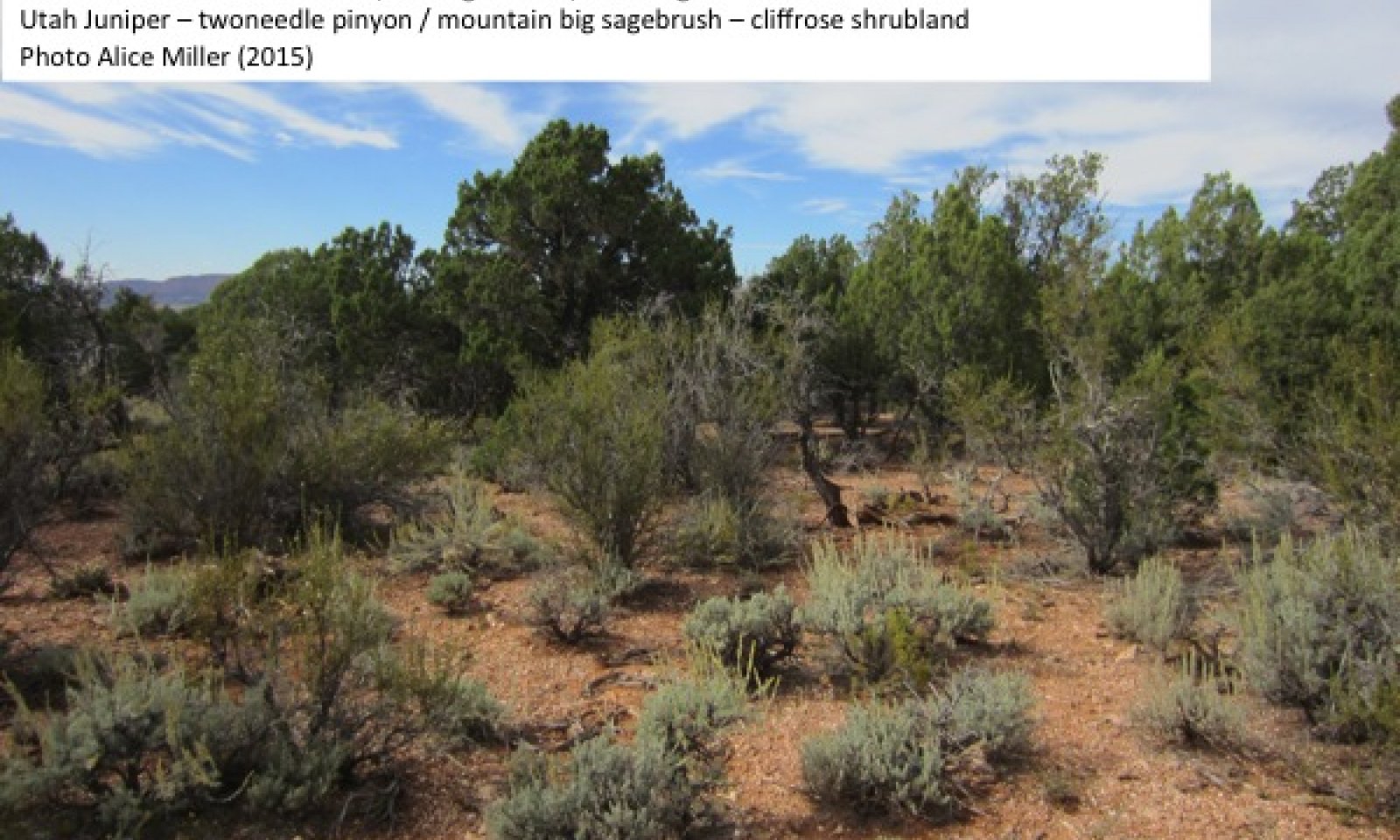
Upland Shallow Loam (Cliffrose)
Scenario model
Current ecosystem state
Select a state
Management practices/drivers
Select a transition or restoration pathway
- Transition T1 More details
-
No transition or restoration pathway between the selected states has been described
Target ecosystem state
Select a state
Description
The reference state was determined by literature review, historical accounts, reports, and observations of trends in plant community dynamics.
The reference state represents the plant communities and ecological dynamics of this ecological site under pre-settlement conditions and a natural disturbance regime. The plant communities of the reference state were similar to those of the current potential state (State 2), and were characterized by a shrubland dominated by mountain big sagebrush and cliffrose, with a sparse overstory of Utah juniper and twoneedle pinyon. Infrequent stand clearing fires would have created mosaics of shrublands in different phases of succession with longer fire return intervals characterized by higher tree cover, and early fire recovery communities dominated by herbaceous species. Cheatgrass was not present in the reference state, and extensive stands of decadent shrubs would likely have been rare without overbrowse and grazing pressures. The primary disturbances included infrequent stand-clearing fire, fluctuations in climate and native ungulate browsing.
Reference State: Plant communities influenced by infrequent fire, light browse and climate fluctuations between wet and dry periods.
Indicators: Dominance by mountain big sagebrush and cliffrose, with a mosaic of plant communities present over the landscape and healthy shrub population structure.
Feedbacks: Infrequent fire and light browse pressure allowed for a self-sustaining shrubland community.
At-risk Community Phase: Community 1.2 is particularly susceptible to invasion by cheatgrass due to a lack of competition and extensive bare soil; however all phases are susceptible to invasion, especially with heavy grazing, browse or other disturbances that remove vegetative cover and disturb soils.
Trigger: Improper livestock grazing, invasive species, and severe overbrowse due to wildlife mismanagement.
Submodel
State 2
Current Potential






Description
This state represents the current potential of this ecological site, and the dynamics include disturbance by livestock, invasive species, overbrowse, and possibly altered fire regimes. This state will naturally fluctuate between all community phases, though Community phase 2.4 is more likely with abusive livestock or overbrowse. Cheatgrass invasion may result in a shortened FRI; many examples exist from other ecological systems where a grass-fire cycle is created (e.g. D'Antonio and Vitousek 1992), but since this has not been observed in this site a grass state is not included in the state and transition model.
Current Potential State: Plant communities influenced by fire, overbrowse and overgrazing, invasive species, and climate fluctuations between wet and dry periods.
Indicators: Decadent shrub communities without recruitment are prevalent, especially cliffrose. A woodland community phase where the understory is largely gone is also present. Cheatgrass may be abundant, and is generally present at least trace levels. Sparse native understory cover.
Feedbacks: A fire regime or manual treatments that allow for shrub recruitment and self-sustaining shrub populations. Improper livestock grazing and/or overbrowse that depletes the understory and prevents shrub, especially cliffrose, recruitment.
At-risk Community Phase: Community 2.2 is especially at risk of cheatgrass invasion.
Submodel
Model keys
Briefcase
Add ecological sites and Major Land Resource Areas to your briefcase by clicking on the briefcase (![]() ) icon wherever it occurs. Drag and drop items to reorder. Cookies are used to store briefcase items between browsing sessions. Because of this, the number of items that can be added to your briefcase is limited, and briefcase items added on one device and browser cannot be accessed from another device or browser. Users who do not wish to place cookies on their devices should not use the briefcase tool. Briefcase cookies serve no other purpose than described here and are deleted whenever browsing history is cleared.
) icon wherever it occurs. Drag and drop items to reorder. Cookies are used to store briefcase items between browsing sessions. Because of this, the number of items that can be added to your briefcase is limited, and briefcase items added on one device and browser cannot be accessed from another device or browser. Users who do not wish to place cookies on their devices should not use the briefcase tool. Briefcase cookies serve no other purpose than described here and are deleted whenever browsing history is cleared.
Ecological sites
Major Land Resource Areas
The Ecosystem Dynamics Interpretive Tool is an information system framework developed by the USDA-ARS Jornada Experimental Range, USDA Natural Resources Conservation Service, and New Mexico State University.
